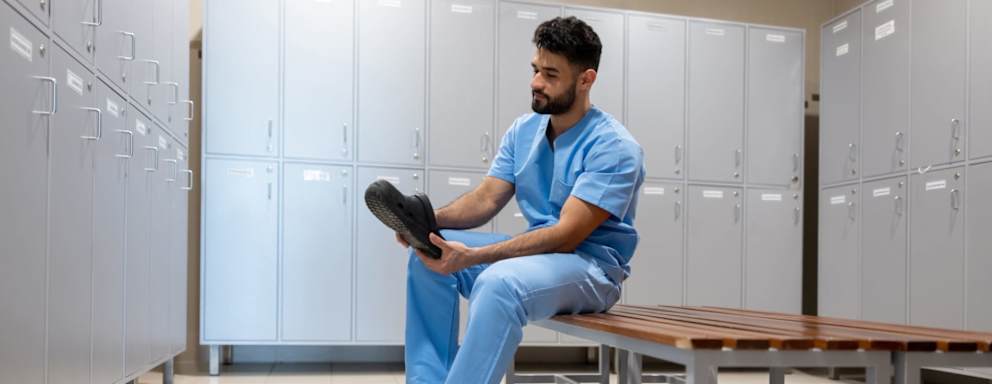Nursing Shoes Get Really Dirty. Here’s How to Keep Them Clean
 Credit: Getty Images
Credit: Getty Images- Healthcare workers’ shoes can collect and spread pathogens to patients and families.
- Routinely cleaning and disinfecting nursing shoes helps reduce the spread of pathogens but can be time-consuming.
- Consider advocating for an eight-second process at your facility and implementing these quick processes at home.
After 12 hours in a pair of poorly fitted nursing shoes, you might be ready for a pair of crutches or 24 hours on the couch. But a poor fit isn’t the only way a pair of nursing shoes can affect physical health — both yours and that of your patients.
Researchers have looked at shoe soles as possible vectors for infectious diseases, but they have not developed an effective decontamination strategy. One study looked at the effect wearing shoe covers might have on infection rates, mortality, and the average length of patient stay in the intensive care unit. It found that shoe covers did not help improve these outcomes.
Yet, a 2022 study epidemiologically linked pathogens on healthcare workers’ shoes with infections in patients, suggesting that the workers’ shoe soles may be a potential mode of transmission for harmful bacteria.
The bottom line? Cleaning and decontaminating your shoes may help reduce the spread of infection to you, your patients, and your family. Here are some simple but effective ways to keep your favorite footwear from inadvertently doing more harm than good.
Disinfect Nursing Shoes, Inside and Out
Each of your feet has more than 250,000 sweat glands and can excrete up to a pint of sweat each day.
This fluid soaks into your socks and the bottom of your shoes, where it’s trapped and grows bacteria and fungus. While the outside of your shoes is a concern, so is the inside!
How to ensure that nursing shoes are properly disinfected, inside and out?
As with many other things, the best process is the one you’ll use consistently.
Let’s start with a device you could advocate for at your facility. The Healthy Sole Plus uses UVC exposure, which purportedly destroys 99.99% of pathogens on healthcare professionals’ shoe soles. Organizations using it today include the National Institutes of Health, the U.S. Department of Veterans Affairs, and New York Presbyterian Hospital.
The device looks like a standing scale, where you place your feet on a platform for eight seconds. One of these devices outside the nursing station may help reduce the spread of bacteria between patient rooms and across hospital floors. Even better, the device is self-cleaning and shatter-resistant.
Your next step is to clean your shoes once you get home. So, what are your options on how to clean nursing shoes there?
You may prefer disinfectant sprays or wipes. If you’re wiping your shoes after each shift, use a new wipe for each shoe and allow the shoe to stay wet with the product for as long as the instructions require. A 3% hydrogen peroxide solution can help remove visible stains, and when mixed with two parts baking soda, it creates a disinfectant paste you can use on the uppers and soles. Add two layers of the paste and then either rinse it or let it dry and wipe it off.
If you’re wearing leather nursing shoes, rubbing alcohol effectively kills germs but is gentler on the material. You can either dip a cloth in three parts rubbing alcohol and one part water or add it to a spray bottle and simply spray your shoes when you come home and let them dry. Bleach is an effective disinfectant, but it will bleach color sneakers. One part bleach and five parts water can work on white canvas shoes.
Microban also makes a sanitizing spray with a citrus scent. You apply the product until your shoes are wet and then air dry without wiping it off.
You also want to reduce odor, which is not just unpleasant, but it’s also a sign of fungal or bacterial growth. Baking soda and vinegar doesn’t kill all viruses but can slow fungal growth. Sprinkle a little baking soda inside and out of the sneakers, then spray with white vinegar. Allow them to sit for 12 hours before removing baking soda.
If you’re looking for a process that eliminates odor and sanitizes and deodorizes shoes inside and out with minimal effort, you’ll want to check out StinkBOSS. Simply plug it in, put the shoes inside, press the button, and set the timer. The product kills bacteria and eliminates odor in approximately 90 minutes, using ozone to kill bacteria and viruses. It also uses mild heat that helps dry sweaty shoes. The box weighs about 13 pounds and holds any shoe up to size nine.
You can also find an ultraviolet sanitizer box using UVC light at home. These products are smaller than the kind you’d see in a hospital, and they may only fit one shoe at a time. The largest we found was made by Coospider, measuring 15.7 x 11.8 x 11.8 inches, which limits the size of the shoe it can handle. However, the bag is portable and takes only five minutes to disinfect and deodorize. With an adapter, you can plug it into your car and disinfect your shoes before you get home.
If you are satisfied with the product you’re using on the outside of your shoes, consider ultraviolet shoe sanitizers for the inside. LedTechnologies has a UVC sanitation product that fits inside your shoes to destroy bacteria and fungi. It works within 15 minutes and helps minimize the potential for athlete’s feet while reducing shoe odors. A similar option is Suncatcher, which operates as a shoe sanitizer and dryer using UVC light.